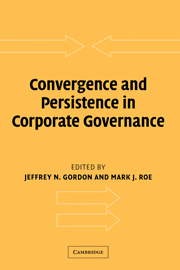Book contents
- Frontmatter
- Contents
- List of figures
- List of tables
- List of contributors
- Acknowledgments
- Introduction
- PART I Systemic issues
- 1 The end of history for corporate law
- 2 A theory of path dependence in corporate ownership and governance
- 3 Path dependence and complementarity in corporate governance
- 4 Globalizing corporate governance: convergence of form or function
- PART II Government players
- PART III Specific institutions
- Index
2 - A theory of path dependence in corporate ownership and governance
Published online by Cambridge University Press: 04 March 2010
- Frontmatter
- Contents
- List of figures
- List of tables
- List of contributors
- Acknowledgments
- Introduction
- PART I Systemic issues
- 1 The end of history for corporate law
- 2 A theory of path dependence in corporate ownership and governance
- 3 Path dependence and complementarity in corporate governance
- 4 Globalizing corporate governance: convergence of form or function
- PART II Government players
- PART III Specific institutions
- Index
Summary
Introduction
Corporate ownership and governance differ among the world's advanced economies. Some countries' corporations are diffusely owned with managers firmly in control, other countries' corporations have concentrated ownership, and in still others, labor strongly influences the firm. During the past half-century since World War II, economies, business practices, and living standards have converged in Western Europe, the United States, and Japan. But their corporate ownership structures have remained different, and different degrees of ownership concentration and labor influence have persisted. What explains these differences? And should they be expected to persist or to disappear?
We show that there are significant sources of path dependence in a country's patterns of corporate ownership structure. Because of this path dependence, a country's pattern of ownership structures at any point in time depends partly on the patterns it had earlier. Consequently, when countries had different ownership structures at earlier points in time – because of their different circumstances at the time, or even because of historical accidents – these differences might persist at later points in time even if their economies have otherwise become quite similar.
In section I, we describe our inquiry. Why, against the background of the forces for global convergence, do the advanced economies differ so much in their corporate ownership structures? For concreteness, our analysis focuses on one important dimension of differences among countries: whether their corporations commonly do or do not have a controlling shareholder.
We distinguish in section I between two sources of path dependence.
- Type
- Chapter
- Information
- Convergence and Persistence in Corporate Governance , pp. 69 - 113Publisher: Cambridge University PressPrint publication year: 2004
- 47
- Cited by

